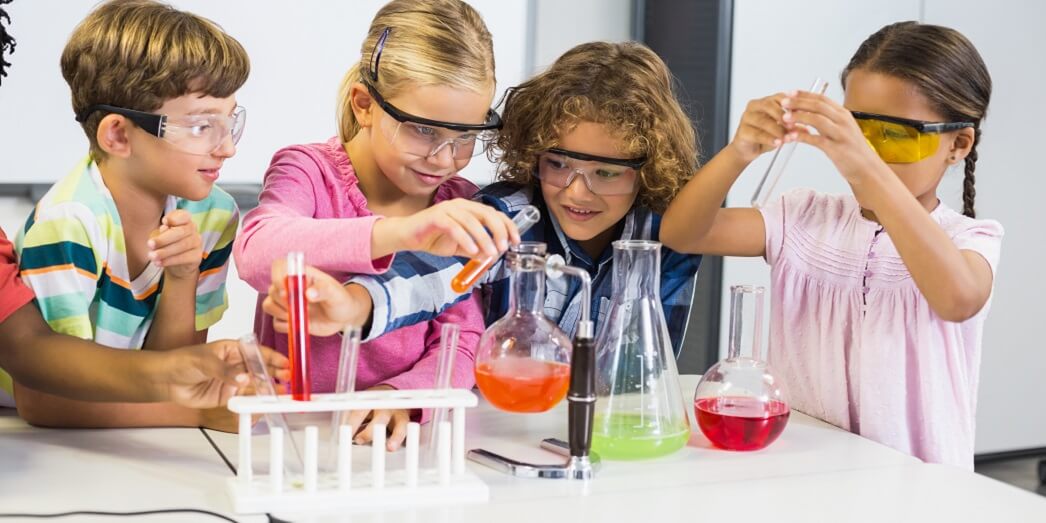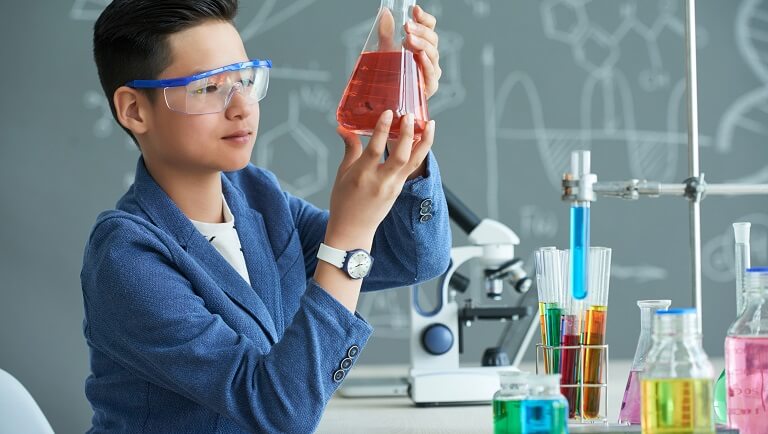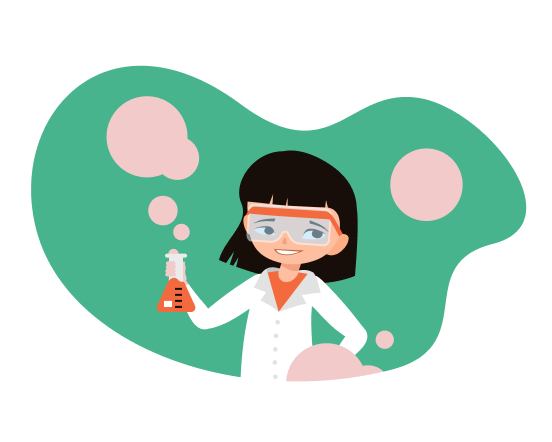
Explaining chemical elements to kids
Elements are widespread. Every day you interact with different types of them. If you take your spoon that you use to eat cereal, you may find Argentum. This guide will help you to understand:
- What is a chemical element?
- How many chemical elements do we know?
- How are chemical elements designated?
- How do chemical elements reach different states of matter?
- What groups do they form?
- What are chemical compounds, mixtures, and isotopes in chemistry?
What is a chemical element?
Undoubtedly, you have already heard about chemical elements. Humans, as a part of the natural world, are surrounded by chemical elements. Everything that exists in the external world, from the mountains and the sea to the air we inhale and the food we consume, and also people themselves comprises simple units called elements. Each element has atoms that are the tiniest unit of building blocks.
You may notice a glass of water. Glass is one of the oldest substances. To get such a beautiful glass, you need the chemical compound silicon dioxide. Our guide can be an assistant for you.
How many chemical elements do we know?
Each element has its properties. Scientists summarised them in the periodic table. In general, you can find 118 elements. Most of them are found in nature. However, some elements are produced by humans. Look at your reflection in the mirror. Now you can understand your body through the six elements:
- phosphorus 1%
- calcium 1,5%
- nitrogen 3%
- hydrogen 10%
- carbon 18,5%
- oxygen 65%
They combined to form thousands of compounds. As you can see, oxygen is crucial for the human body. Oxygen allows you to exist. Also, this element that makes up air is significant for the survival of all plants and animals.
How are chemical elements designated?
As you may notice, elements in the periodic table have a unique number. You can identify each of them using specific names and symbols. So scientists from different countries understand each other easily while describing elements. Here is a brief explanation of the three-component of each element designation. We will explain it from top to bottom:
The atomic number
The atom is the smallest unit of an element. You need to make an effort to see it. There are different particles of each atom, such as protons, neutrons, and electrons. A positive charge that a proton has is located at the center of the atoms. A proton is an essential part of an atom. If you take hydrogen, it has the smallest atomic number (1). It means that hydrogen is a very light element and has only one proton in its nucleus.
The first letter(s)
As you notice, element naming may be very long. So in the table, chemical elements are marked by the first letter or letters. If you take Argentum (silver) in the table, it has the abbreviation Ag.
The atomic mass number
This shows the number of protons and neutrons in the nucleus of an atom of a given chemical element. It refers to another question about isotopes that we will discuss later.
How do chemical elements reach different states of matter?
The world is very diverse. Everything you use and see has various states of matter. Going back to the glass of water. What will happen with your water in winter if you leave it outside? You will see that water will be gradually turning into ice. Also, you can use water to do ice cubes for lemonade in summer. How can we explain these processes? If you use elements, you will understand them.

Elements can be in three states of matter such as solid, liquid, and gas. Elements can transform from one form into another. These changes arrange atoms in different ways. There are two essential characteristics that every element has. It is form and volume. Let’s take a look at more details:
- Solid form. It is characterized by fixed volume and form. Although sometimes we can change its shape.
- Liquid form. It is characterized by fixed volume and variable form. Liquids take the shape of the container.
- Gas form. It is characterized by variable volume and form. Gases always occupy the full magnitude of the container, which is nearly the same as liquid forms.
There are metamorphoses between different types of states. To change from one to another, you can heat it or cool it off. For example, when we heat an ice cube it turns into water.
What groups do chemical elements form?
Generally speaking, a group or a family is a column of elements in the chemical elements periodic table. There are 18 numbered groups. They have similar physical and chemical properties, the number of outer electrons and a specific name. For instance, if you take group one, there is one outer electron, while in group eight, there are eight outer electrons. Also, you can recognize different groups through their specific name. Let us describe some of the groups:
Alkali Metals
This is the first column in the periodic table. How water reacts with elements is interesting here. Specifically, ‘alkalis’ is a designation for reactions that produce acid-attacking compounds. We cannot find the alkali metals in a pure form. They exist only in compounds with other elements. For example, everyday salt consists of sodium.
Alkaline Earth Metals
The next column is Alkaline Earth Metals. This group is a collection of reactive metals. Scientists tend to find them in the inner parts of the Earth. Here we can see such an example as Earth’s crust. Calcium is nearly the most common element on our planet. You interact with something that consists of it. For example, oranges, broccoli, and milk are good sources of calcium.
Transition Metals
One of the largest families is Transition Metals. Many of these elements can easily change their forms. We have already told you that silver has a specific name Argentum. It gets its name from Latin. You can see this metal on jewelry. So it is a precious metal.
Lanthanides
Also known as ‘rare earth metals’, lanthanides were discovered mixed in Earth’s crust. Most of them are abundant. For example, take a fluorescent lamp. Some can use lanthanum to reduce yellow light.
Actinides
Radioactivity is a distinctive feature of that type of element. The last nine elements are produced in artificial conditions. Here you can find scientists’ names. It is considering curium that is a precious metal. It has a beautiful red luminescence in the dark. Notably, it was named because of a stunning French chemist Marie Curie. She also discovered the element polonium.
The Halogen Group
The definition of the word ‘halogen’ is ‘salt former’. The meaning of the names is rather interesting. Halogens get their name because they interact with metals to form salts. Chlorine is a good example. It is a highly reactive gas. That is why the chlorine level should be under control in swimming pools. You may use it to examine the quality of your water.
Noble Gases
Another fascinating word we can find there. You may be bewildered by the word ‘noble’. It means that noble gases do not interact with other elements. Their atoms never form bonds in nature, not even with atoms of their kind, and so they are always gases at room temperature. Have you ever thought about flying party balloons? They can do it using helium that is the second lightest element.
What are chemical compounds, mixtures, and isotopes?
Elements can combine in various ways to make nearly ten million compounds. Scientists also explore why certain elements are interacting to form compounds.

Chemical reactions are widespread and happen all the time. We can call it the most wonderful demonstration of existence. Also, let briefly look at what is chemical compounds, mixtures, and isotopes.
Chemical Compounds
A chemical compound is a substance that consists of atoms from more than one element that are held together by chemical bonds. For example, table salt, or sodium chloride, is a chemical compound made up of atoms of two chemical elements — sodium and chlorine.
Mixtures
A mixture is a combination of substances that can be separated by physical means, such as filtering. Mixtures can be classified as solutions, colloids, and suspensions. In solution mixtures, a substance is thoroughly and evenly mixed or dissolved into another sense. Seawater is a solution. Colloid contains unevenly spread particles and clusters that are too small to see.
Isotopes
Isotopes are varieties of atoms of a certain chemical element that have the same number of protons and electrons, but differ in the number of neutrons. They have the same atomic number but different atomic masses. For example, helium has two isotopes: one contains three neutrons (He-3), the other has four (He-4).

new engaging articles



